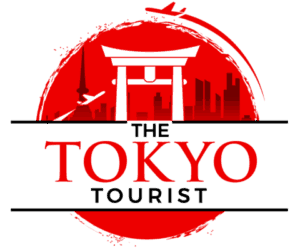Deprecated: mb_convert_encoding(): Handling HTML entities via mbstring is deprecated; use htmlspecialchars, htmlentities, or mb_encode_numericentity/mb_decode_numericentity instead in /home2/thetoky7/public_html/wp-content/themes/acabado/functions.php on line 2119
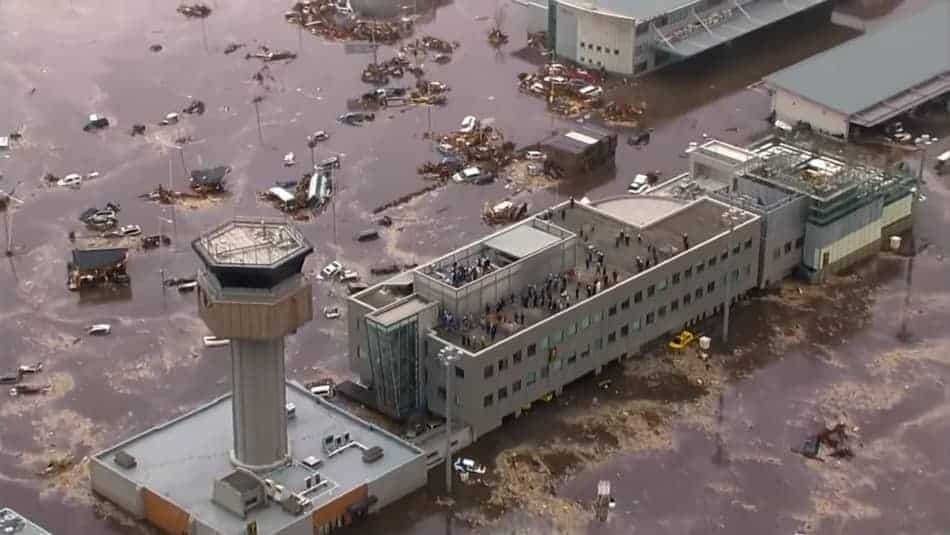
After the Fukushima nuclear disaster in March 2011, a lot has been written and said about radiation levels in Japan in general and in Tokyo more specifically. Is it safe to travel to Japan? Is it safe to travel to Tokyo? And is the food contaminated from radiation? Should you be worried about radiation in seafood? What about the tap water? Is the water completely safe? Should pregnant tourists avoid Tokyo because of radiation?
I do not claim to be an expert, but I’ve looked at the official statements and the official travel advice as well as the radiation numbers. So is Tokyo safe from Radiation? Yes, Tokyo is completely safe from radiation. In fact, you are worse off visiting cities like New York, Paris, Singapore (city-state), and London. Is it safe to eat the food and drink the water? Yes, you should not be worried about eating the food nor drinking the water. Still not sure? Take a look at the official statements and the official radiation readings below.
If you don’t trust everything the government tells you, you can always do what I did. I bought a truckload of potassium iodide tablets in case of a nuclear emergency! Better safe than sorry, right?
If you don’t want to read about the disaster, and only want the radiation facts for food, water, air, and pregnancy, click here.
Quiz: Do Japanese Police Carry Guns?
The distance from the Fukushima Nuclear Power plant to Tokyo is 140 miles (226 km)
The Fukushima Disaster
What actually happened? I’m not going to bore you with all the details, but let’s just get a quick overview in the form of some bullet points.
- At 2:46 p.m. on Friday 11 March 2011 an undersea megathrust earthquake occurred off the Pacific coast of Tōhoku.
- The earthquake had a moment magnitude of 9.1 and lasted for 6 minutes. It was the most powerful earthquake ever recorded in Japan and the fourth most powerful earthquake in the world since modern record-keeping began in 1900.
- When the earthquake occurred, the nuclear reactors at Fukushima Daiichi Nuclear Power Plant automatically shut down, and the power generation due to fission of uranium stops. This automatic shutdown is a safety precaution automatically triggered after the earthquake.
- When the power generation at the power plant was stopped, the emergency generators kicked into action. This is an absolute necessity to control and operate the pumps tasked with cooling the reactors. Even though the fission of uranium stops, the fuel rods still produce massive amounts of heat.
- Then the tsunami struck… Waves of heights of up to 21 feet (6.5 m) crushed into and flooded the diesel generators and essential service water building. Station blackout.
- The powerful underwater earthquake had triggered a tsunami with heights of up to 133 feet (40.5 meters) that traveled up to 6 miles (10 km) inland.
- After the tsunami struck the emergency generators at the Fukushima Daiichi Nuclear Power Plant, it rendered them useless. The circumstances were now critical because there was no power to cool the nuclear reactors. The situation was quickly moving towards a nuclear meltdown.
- Because of the constant heat production, the temperature and pressure kept rising.
- In turn, this led to three nuclear meltdowns, hydrogen-air explosions, and the release of radioactive material. It happened on March 12, 2011, to March 15, 2011.
Consequences of the Fukushima Disaster
How bad was it? Explosions resulting from the buildup of pressurized hydrogen gas punched holes in the containment vessels which led to leakage of radioactive materials. Because of concerns over possible radiation exposure, government officials established an 18 miles (30 km) no-fly zone around the facility, and a land area of 12.5 miles (20 km) radius around the plant. Residents within approximately 232 square miles (600 square km) were evacuated. In total 154 000 people were evacuated from their homes, and still many are barred from returning to their homes inside the “exclusion zone.” The estimates are that over 90 000 still haven’t returned to the region.
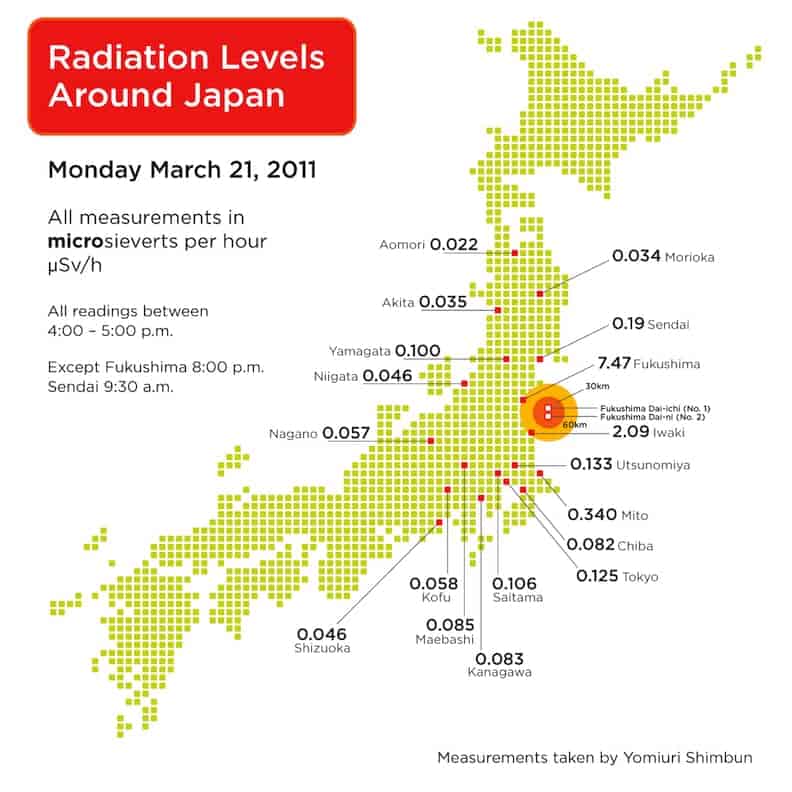
Tokyo Radiation Levels Today (2018) – Constantly Updated
Now that we’ve covered why people certainly have the right to ask about the radiation levels in Tokyo let me provide you with a link to check today’s radiation levels in Tokyo. They are taking measurements every hour in Shinjuku, Tokyo. It’s conducted by the Tokyo Metropolitan Institute of Public Health which mission is to ensure the safety of the outdoor and indoor environments in Tokyo.
Their website is in Japanese, so I’ve taken the liberty to translate it for you through Google.
- Click here (opens in a new window) to see today’s radiation levels in Tokyo. (English)
- Click here (opens in a new window) to see today’s radiation levels in Tokyo. (Original, Japanese)
Here you see the exact numbers, but if you’re like me, you’re not an expert on radiation. What are the safe radiation levels? How does this compare to other cities?
Tokyo Compared to Other Major Cities
Like I said earlier, I’m no radiation expert, so I’ll be sure to provide you with all the sources so you can check the numbers for yourself. Also note, all the information is from government agencies.

So if you are worried about traveling to Tokyo because of the assumed radiation, you should be even more worried about traveling to the cities with higher levels of radiation. Are all the cities dangerous? What are the accepted radiation levels?
What Are the Accepted Radiation Levels?
To get a grasp of how much radiation is deemed safe to be exposed to, let’s take a look at the legal limits for occupational exposure in the United Kingdom and the United States.
United Kingdom
This is from the current UK legislation:
- The UK limit for occupational exposure to radiation is
- The lens of the eye is, 20 mSv/year
- The rest of the body, 50 mSv/year
Read all about it: The Ionising Radiations Regulations 2017
United States
This is according to the Office for Health, Safety and Security:
- The U.S. limit for occupational exposure to radiation is 50 mSv/year
Read all about it: Occupational Radiation Exposure Monitoring, Analysis & Reporting
Both the United Kingdom and the United States deem it to be within acceptable limits if you get exposed to up to 50 mSv/year on your job. So how much exposure do you get from just living in Tokyo?
Exposure to Radiation in Tokyo
All the Japanese radiation date is stated in μSv/hour (μGy/hour). So wow we need to calculate μSv/hour to mSv/year. Thankfully the calculations are easy.
Take the μSv/hour and multiply it by the number of hours in a year. You get the number of hours in a year by multiplying the number of hours in a day with the number of days in a year. Like this: 365.25 (.25 due to the leap year) * 24 = 8 766.
The average μSv/hour in Tokyo is 0.036-0.037. Let’s round up to 0.040 to the have a good safety margin!
0.040 * 8 766 = 351 μSv/year
351 μSv/year = .351 mSv/year
Far Below the Accepted Limits
So there you have it! The radiation in Tokyo is .351 mSv/year. This is, in theory, the level of radiation you’re exposed to if all you do 24/7/365 is stand still, in Tokyo, without drinking or eating. But people do more than stand still and soak up radiation from the air.
Is it Safe to Eat the Food in and Drink the Tap Water in Japan?
Let’s start with the food. Professor Jim Smith, from the University of Portsmouth, and Dr. Keiko Tagami, from the Japanese National Institute of Radiological Sciences, conducted a comprehensive study of Japanese diet following the Fukushima Disaster. They concluded that the radiation in the average diet in the region is very low. Thus the food in the rest of Japan is also safe.
Dr. Keiko Tagami of the Japanese National Institute of Radiological Sciences stated in June 2017: This study gives us the evidence to explain to people how contamination levels will change over time. It gives us confidence that radiation doses in the average diet in the Fukushima region are very low and do not present a significant health risk now or in the future.
Government officials test the water rigorously every day, and it’s been safe to drink since a slight scare 23 March 2011. Read more about the tap water here.
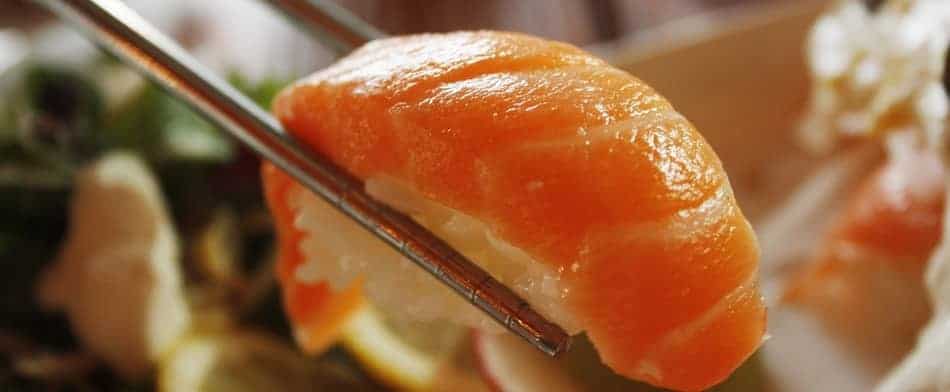
What About the Seafood?
This is a big one, so I’ll be sure to provide you with some credible sources so you can check them out for yourself if you feel like it.
Radiation from the Fukushima Nuclear Power Plant is still seeping into the ocean. How dangerous is it? Ken Buesseler, a radiochemist with the Woods Hole Oceanographic Institution, put it like this: If you get up every day and go swimming in those waters for an entire year, you have an additional dose, but it turns out to be about 1 000 times smaller than a single dental X-ray.
But what about the organisms not going for daily swims for a year, but who actually live in the water? The delicious seafood.
The answer, then and now, is no, scientists say. The Fukushima leaks were minuscule compared to the vast scale of the Pacific, said Nicholas S. Fisher, an expert on nuclear radiation in marine animals at Stony Brook University in New York. The disaster added just a fraction of a percent to the radiation that’s already in the ocean, 99 percent of which is naturally occurring.
At those levels, you could eat piles of Pacific fish and have nothing to worry about from radiation, Fisher said. The dose of Fukushima-derived radiation from the average tuna fillet, he explained, “would be far less than the total radiation you’d get from eating a banana or flying in an airplane.” – Source and read more about it at oceana.org.
According to the prefectural fishery laboratory, 95 percent of the 8,502 samples collected in 2016 showed radioactive cesium at levels that were hardly detectable, while readings for another 422 samples were below the limit. Read more.
Japan Travel Pregnancy Radiation. Is it Safe?!
This train of thought must be very common for expecting mothers thinking about traveling to Japan, as you do not want to take any chances when you’re pregnant. The human embryo and fetus are particularly sensitive to ionizing radiation, and the health consequences of exposure can be severe, even at radiation doses too low to immediately affect the mother.
The dose that is allowed by the Nuclear Regulatory Commission for a pregnant woman who is occupationally exposed to radiation is 5 mSv/year. Let me be clear. This is the employer’s responsibility when it comes to the exposure to radiation at work. So you can still be completely safe while being exposed to up to 5 mSv/year at work in addition to the normal exposure from everyday life.
The yearly average exposure to radiation in Japan is 3.83 mSv (2018). Therefore, if you are pregnant, you are completely safe in Japan during your pregnancy, even in the Fukushima district.
Do you have any questions about flying while pregnant? Check out this useful and thorough FAQ from Health Physics Society.
Let’s get the full picture and compare that to the average radiation in the U. S.
How Much Radiation Are You Exposed to in Japan Compared to the United States?
You get radiation from a lot of things. The air you breathe in, the food you eat, the water you drink and radiation from space. And if you’ve ever taken an X-ray, you got exposed to a couple of weeks worth of everyday radiation in just a couple of seconds.
How does the radiation levels in Japan compare to the U. S. and the world in general?
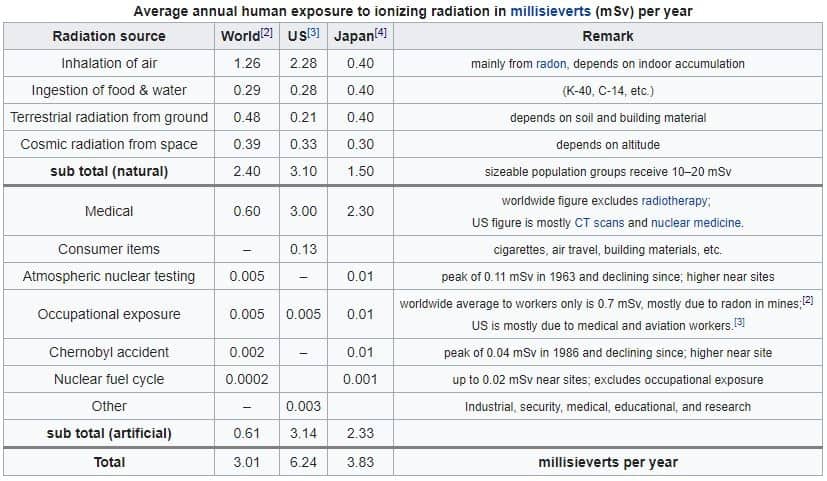
Conclusion
Yes, both Tokyo and Japan are safe from background radiation. It’s also safe to eat the food and drink the water. In addition to the Japanese government attesting to this, the World Health Organization along with numerous non-government agencies report the same thing. The information is credible, so there’s no need to worry.
Were you considering not traveling to Tokyo because of possible exposure to radiation? If so, did this article in any way change your mind? Leave a comment.
Why not pin it for later? You can also follow the The Tokyo Tourist on Pinterest. 🙂
